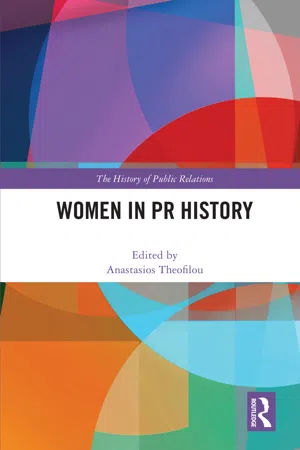
- 120 pages
- English
- ePUB (mobile friendly)
- Available on iOS & Android
Women in PR History
About this book
The history of PR has received limited attention over the years, and especially the role of women in PR has been an 'untold' story thus far. This book is the first attempt, following research presented at the International History of Public Relations Conference, to shed light on the significant role that female pioneers have played in the evolution of PR.
This book explores the field in a way that will offer insight of the significance that women had in the evolution of PR, with diverse chapters that provide rich perspectives on women's contributions to PR throughout the years and across the globe. It opens with an overview of women in public relations. Later chapters focus on the case of Turkey, which seems to have a rich history of women in public relations, then on specific cases from Oceania (Australia), Europe (Spain), Asia (Malaysia and Thailand) and America (United States). The final chapter deals with the case of Inez Kaiser, who was the first African- American women to open a US public relations agency.
This book will add knowledge and understanding to the fields of PR history and historiography. Academics and researchers will find the volume appropriate for research and teaching. Practitioners will also find the book extremely relevant for training, short courses and professional practice.
Frequently asked questions
- Essential is ideal for learners and professionals who enjoy exploring a wide range of subjects. Access the Essential Library with 800,000+ trusted titles and best-sellers across business, personal growth, and the humanities. Includes unlimited reading time and Standard Read Aloud voice.
- Complete: Perfect for advanced learners and researchers needing full, unrestricted access. Unlock 1.4M+ books across hundreds of subjects, including academic and specialized titles. The Complete Plan also includes advanced features like Premium Read Aloud and Research Assistant.
Please note we cannot support devices running on iOS 13 and Android 7 or earlier. Learn more about using the app.
Information
1Re-examining the existence of the “velvet ghetto” and the “glass ceiling”
Examining the status of American women in public relations a generation later
Introduction
Literature review
Work–life balance
Salary differences
Women in public relations leadership
Other factors
Methodology
Results
Responses to the question: How has your experience as a woman working in the communications and public relations industry changed from the start of your career until now?As I’ve grown in my career, I’ve found it easier to gain respect for what we do as professionals and how we do it. However, I have not seen as significant of an increase in the understanding of the position or its business value as I would have expected over a 30-year period. Because of this, it is still challenging for women to be seen as equal executives in companies where communications is considered a soft skill. Often, when female communication executives are fully respected as an equal executive partner, it is in spite of their communications leadership, not because of it.At the start of my career, most of the leaders were men, but that has changed to include many more women in leadership roles or even the top communications role. I also believe more professional development and leadership growth opportunities exist now than when I began my career more than 30 years ago.Today, women are in executive positions in most publicly-traded companies and many of the current top PR agency leaders are women.Opportunities for women have grown dramatically since I entered the communications profession.Responses to the question: Do you perceive any differences between how men and women are treated in the PR field?I have not felt I was treated differently; if I was, it was to my benefit.Absolutely! When a man is the senior PR professional, the communications profession often is taken more seriously.Early on, my perception was that my male counterparts were brought into conversations earlier than my female counterparts, who tended to be brought in when there were actual tactics to be completed. Men were more relied on for a strategic view and women were more the “task takers” who created the communication and saw to the details of approvals and distributions.Years ago I would have responded, “Yes” to this question but many things have changed and things are much better today than they used to be.Responses to the ques...
Table of contents
- Cover
- Half Title
- Series Information
- Title Page
- Copyright Page
- Contents
- List of contributors
- Introduction
- 1 Re-examining the existence of the “velvet ghetto” and the “glass ceiling”: Examining the status of American women in public relations a generation later
- 2 Women in public relations: A thematic analysis of ECM data (2009–2019)
- 3 ‘Signum authenticum’ of women: Herstories in Turkey’s public relations during the early years
- 4 Professional standards of PR in three decades through the lenses of Turkish women presidents of IPRA
- 5 Betty Stewart, Orientalism and Oriental Cavalcade: Entertainment public relations in late 1950s Australia
- 6 The militant documentary films of Helena Lumbreras as dissent and protest public relations
- 7 A ‘herstory’ of Malaysian public relations: Paddy Schubert, Malaysia’s women PR pioneer
- 8 The Loi Krathong festival and Nang Noppamas: Applying current ‘PR’ theory to identify the first Thai female PR practitioner
- 9 Inez Kaiser: The perseverance of a public relations pioneer
- Conclusions
- Index